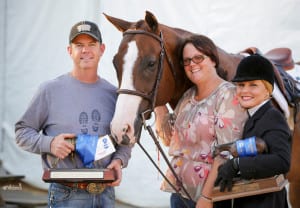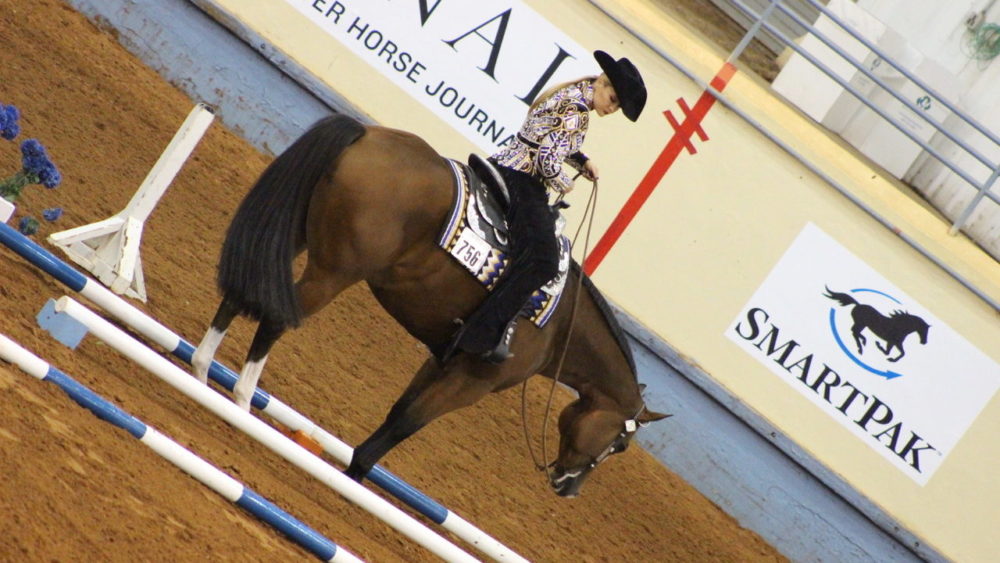Much emphasis is placed on working on and perfecting the “complicated moves” in a pattern: the lead change, the lope/trot over logs, or the patterns with tons of speed changes. However, the skills that earn the most plusses or minuses on a judge’s card are often thought to be more “basic” in nature.
We spoke with the experts to get their take on perfecting the fundamental movements that are frequently overlooked in a pattern. In this three-part series, we get advice from Leonard Berryhill, John Briggs, and Sara Simons on making the (1) stop, (2) back, and (3) side pass consistent point-earning opportunities.
Our experts discussed the stop in part 1 and today’s focus is the back. Whether backing through a trail obstacle, in a horsemanship pattern, or even in a line-up in a pleasure class, this “basic” maneuver has the potential to make or break a class.
Leonard Berryhill (The Scoring Approach):
 To perform a clean, correct back, Berryhill looks to see the rider softly lift their hand and use their leg gently to get the horse to back. He doesn’t mind hearing a soft kiss or cluck as an aid to communicate with the horse.
To perform a clean, correct back, Berryhill looks to see the rider softly lift their hand and use their leg gently to get the horse to back. He doesn’t mind hearing a soft kiss or cluck as an aid to communicate with the horse.
Berryhill likes to see the connection and communication with the horse where the rider moves slightly and responds quickly and quietly, while remaining smooth and straight throughout the back. He wants to see the horse back respectfully and softly in the bridle, without opening their mouth and trying to avoid the contact or lifting their neck in protest.
Berryhill finds that the most significant mistakes in horsemanship and western riding are where the horse does not back straight or they do not back enough. He says, “So many people don’t take enough steps or take too many steps. If the pattern says back five steps, then back five steps.” It is also essential to have your horse back in a straight line to avoid losing points on this element.
Despite what many people think, Berryhill finds that speed often does not give a quality back. He says, “The intention of the maneuver is not to fly backward like a reiner. It is to communicate and connect with the horse to have a smooth, willing, quiet back.”
When backing an “L” or “Z” in a trail pattern, Berryhill wants to see a clean, smooth back that negotiates the obstacle without ticking a pole. He wants the back to be smooth, with the right cadence to move through the maneuver without going so fast that the horse can’t manage the corners properly.
Berryhill emphasizes that, “Every maneuver in a pattern involves a cadence and the trail is no exception. Most of the time, you need to take your time when backing through an obstacle to ensure that it is done properly and smoothly. Trail involves more of a draped rein back, but I still want to see the rider lift their hand to steer the front end.”
Like in horsemanship or western riding, Berryhill still wants to see the horse stay in the same frame, and the rider remain soft while backing through an obstacle. Berryhill personally appreciates seeing a rider subtly handling and controlling their horse. He wants to see the cues, but he wants them to be soft and the horse to respond to them willingly. He also wants to see the horse listen to the rider and not back through the obstacle independently.
Berryhill admits, “I won’t give you a plus for a very slow back, but I typically won’t take any credit away either. So, therefore, slower is safer. A correct, soft, responsive back with cadence is how you impress me.”
Berryhill reminds riders that it is ok to take a breath between maneuvers. But, he says, allow your horse to pause and settle before asking them to start backing up. When he sees this momentary pause, he believes it is evidence that the rider is a true horseman, and they know to make sure everything is in the right place to set up a correct, straight back before engaging in the maneuver.
John Briggs (The Foundational Approach):
 Once again, Briggs believes that the best way to set yourself up for a correct back is to teach your horse to back correctly. Like the stop, Briggs has a three-step approach for teaching a horse to back.
Once again, Briggs believes that the best way to set yourself up for a correct back is to teach your horse to back correctly. Like the stop, Briggs has a three-step approach for teaching a horse to back.
Briggs teaches his horses to back straight, smooth, and with light contact. The first step in accomplishing this is perfecting the “hand back.” Next, Briggs will lift his hand and teach the horse to back away from pressure in its mouth to perform this maneuver.
Once the horse responds consistently to the hand back, Briggs will begin teaching them the “stirrup back.” This involves teaching the horse to back up based off the rider putting equal pressure in the bottom of the stirrups and pushing their weight into their butt to push down on the horse’s hind end. As before, Briggs will lift his hand to reinforce the backward motion if the horse does not respond to the stirrup weight.
Finally, once the horse consistently backs off of the stirrup pressure, he will teach them to back off a squeeze. He says that teaching the animal to stop appropriately is essential for a clean back. If the horse can stop and come back to your feet, they are set up to learn to back off the squeeze. The “squeeze back” involves putting constant, even pressure with both calves to push the horse into the back.
Briggs advises that trainers and amateurs use aids when teaching the animal to back straight, particularly in the early training phases. He prefers to use railroad ties because the horse can’t push them around and learns to respect the boundaries a little better. In addition, teaching the animal to back through the railroad ties teaches them to position their body correctly on their own, making them a more active participant in their training because they have to think about what they are doing. This method also teaches the rider to apply unequal pressure, thereby requesting an uneven back.
Once the horse has mastered all three back commands independently, Briggs will put all of them together to give the horse a controlled, straight back with minimal contact on their mouths.
Briggs prefers to move the animal’s hind and front ends separately when backing a corner, moving the rear end first. Then, he advises riders performing an “L back” or a back around a corner, “Back straight, nearly stop at the corner, then put your outside leg on to push the ribcage over while moving the hind into position. Then, move the shoulders over to straighten them out and finish the corner.” He says this process will keep the horse more balanced than trying to swing them around the corner in one continuous motion.
Briggs advises that riders focus on making their backs a slow and controlled maneuver to avoid mistakes.
Sara Simons (The Body Control Approach):
Once again, Simons believes the key to performing a clean back is having complete control of your horse’s body – meaning that you can move their body parts independently of one another.
Specifically, Simons believes that a rider needs to move the horse’s front and hind ends separately. She recommends working on forehand turns and turns on the haunches to establish the leg cues necessary to independently move the horse’s body parts. Simons feels that, “maneuverability is the key to a clean back.”
To back straight, Simons says the rider needs to guide the horse with their legs, making sure to apply even pressure on each side. She recommends that teams practice backing frequently, focusing on reinforcing responsiveness to pressure. Therefore, even pressure should tell your horse you want them to back straight. Conversely, unequal force should function to move the horse over (which would be necessary for supporting a corner or serpentine) with the appropriate body part responding to move away from corresponding pressure.
Simons says she teaches her clients to look down over their horse’s withers to ensure a straight back because, if you look around too much, riders will often unknowingly be shifting their weight around at the same time. This will result in changing pressure on the horse’s sides as you move through your back. Ultimately, the more you wiggle around, the more your horse is likely to follow suit.
Finally, Simons advises that riders take their time through any backing maneuver in a pattern to ensure they perform the maneuver correctly, straight, and within the boundaries of the pattern.
***
Remember: the goal of any pattern element is to complete it correctly with light contact. And, all of our experts agree, the best way to ensure both of these goals are met is by consistent, correct practice at home and at shows.
Stay tuned for part 3 of our Perfecting the Pattern series when we will talk to the experts about the side pass. And in case you missed it, be sure to check out Part 1 – The Stop.








